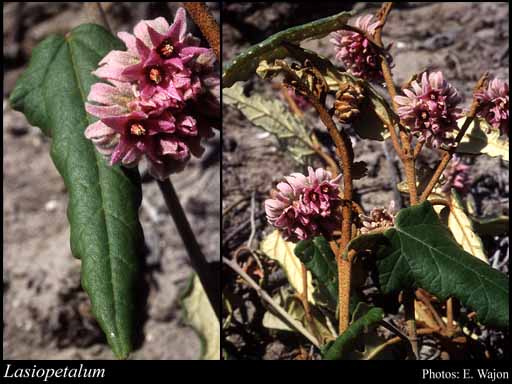- Reference
- Trans.Linn.Soc.London,Bot. 4:216 (1798)
- Name Status
- Current

Scientific Description
Family Sterculiaceae.
(Subfamily Byttnerioideae), Tribe Lasiopetalae.
Habit and leaf form. Shrubs; non-laticiferous and without coloured juice. ‘Normal’ plants. Leaves well developed. Plants with roots; non-succulent. Leaves cauline. To 0.25–1.5 m high. Self supporting. Mesophytic. Not heterophyllous. Leaves small, or medium-sized; alternate (commonly), or opposite (L. oppositifolium); with blades; petiolate. Petioles wingless. Leaves with ‘normal’ orientation; simple; not peltate. Leaf blades neither inverted nor twisted through 90 degrees; dorsiventral; entire, or dissected; flat; ovate, or linear; pinnately veined; cross-venulate; cordate. Mature leaf blades adaxially glabrous (or nearly so), or pubescent (‘sparsely stellate-hairy’); abaxially pubescent (‘closely stellate hairy’), or glabrous (or nearly so). Leaves without stipules. Leaf blade margins entire; revolute. Leaf anatomy. Hairs present; complex hairs present. Complex hairs stellate.
Reproductive type, pollination. Fertile flowers hermaphrodite. Unisexual flowers absent. Plants hermaphrodite. Plants homostylous.
Inflorescence and flower features. Flowers aggregated in ‘inflorescences’; not crowded at the stem bases. Inflorescence many-flowered, or few-flowered. Flowers in cymes. Inflorescences simple; leaf-opposed. Flowers pedicellate; bracteolate (up to 3 present, sometimes small, though longer than the calyx in L. oppositifolium); small; regular; not resupinate; neither papilionaceous or pseudo-papilionaceous; 5 merous; cyclic; tetracyclic, or tricyclic. Perianth with distinct calyx and corolla; 10, or 5 (rarely); 2 -whorled, or 1 -whorled (rarely); isomerous. Calyx present; 5; 1 -whorled; gamosepalous; lobed. Calyx lobes markedly longer than the tube. Calyx spreading; hairy (, densely stellate-hairy and/or with simple glandular hairs on the outer surface, the upper surface with appressed or sparse stellate hairs to almost glabrous), or glabrous (on upper surface); exceeding the corolla; regular; neither appendaged nor spurred; pink, or purple. Calyx lobes ovate (to narrowly or very narrowly so). Corolla vestigial (‘scale-like’), or absent; 5; 1 -whorled; not appendiculate; polypetalous; regular. Petals small and scale-like. Androecium present. Fertile stamens present. Androecial members definite in number. Androecium 5. Androecial members free of the perianth; free of the gynoecium; all equal; free of one another; 1 -whorled. Androecium exclusively of fertile stamens. Stamens 5; all more or less similar in shape; isomerous with the perianth; filantherous. Anthers separate from one another; all alike; dehiscing via pores, or dehiscing via short slits (, pores or slits ‘terminal or inwardly oblique’); bilocular. Fertile gynoecium present. Gynoecium 3(–5) carpelled. The pistil 3(–5) celled. Carpels reduced in number relative to the perianth, or isomerous with the perianth (rarely). Gynoecium syncarpous; eu-syncarpous; superior. Ovary plurilocular; 3(–5) locular. Gynoecium stylate. Styles 1; simple (‘filiform’); apical; hairy (with large reflexed stellate hairs). Placentation axile.
Fruit and seed features. Fruit dehiscent; a capsule. Capsules valvular. Dispersal unit the seed. Fruit 3–5 seeded (‘usually 1 seed per cell’).
Geography, cytology, number of species. Native of Australia. Endemic to Australia. Australian states and territories: Western Australia, South Australia, Northern Territory, Queensland, New South Wales, Victoria, and Tasmania. South-West Botanical Province. A genus of ca 35 species; ca 24 species in Western Australia; 8 endemic to Western Australia.
Additional comments. Named from the Greek lasios, hairy, shaggy; petalon, leaf or petal; alluding to the hairy calyx. Information on the location and number of extant species is outdated.